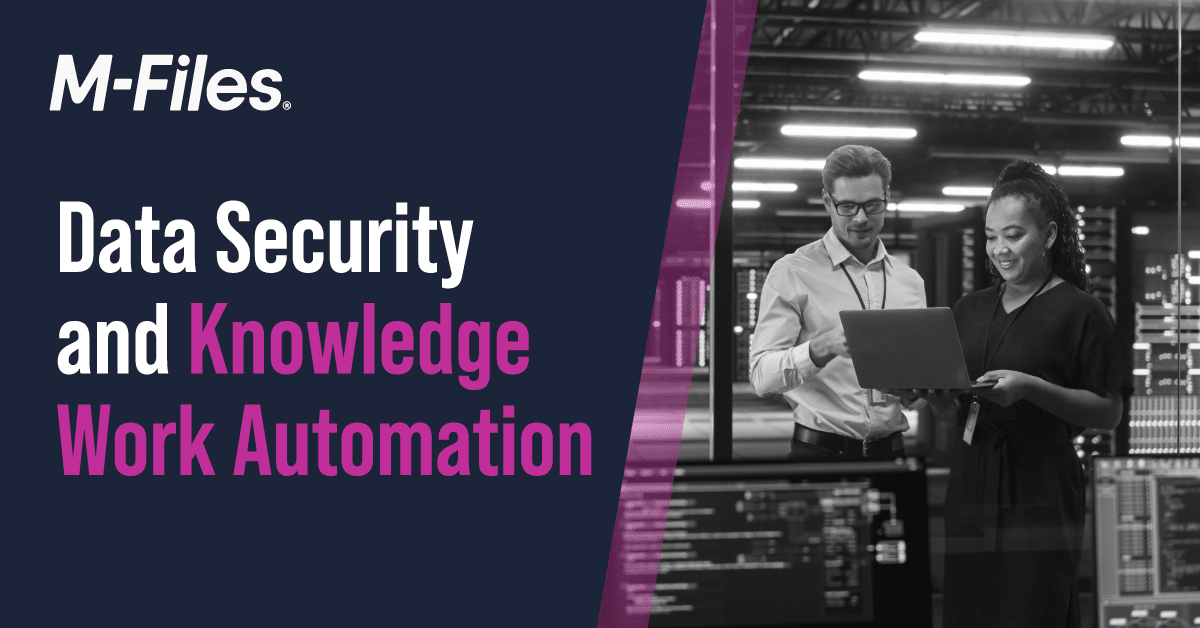Data Security and Knowledge Work Automation

In 2023, the number of knowledge workers in the United States was estimated to be more than 100 million, with more than 1 billion knowledge workers globally. These highly trained workers drive value for organizations by applying their creative and problem-solving skills.
With the rise of generative AI, there’s been a renewed push to automate the mundane and repetitive activities associated with knowledge work. Boasting advanced skillsets and knowledge bases, knowledge workers tend to be highly compensated. Reducing the amount of time they spend on busy work and boosting their efficiency is a priority for most businesses.
AI-enhanced knowledge work automation software is helping organizations unlock the value of knowledge work. Advanced technologies are automating tasks, processes, and actions that previously required human interaction.

AI and Automation of Knowledge Work
With generative AI technology in the mix, knowledge work automation platforms become even more powerful. They help workers organize information, understand the context of documents, and interact with their company knowledge base using natural language inputs.
The result? Knowledge workers—even those without coding know-how—can use automation to make documents easier to find and use in the proper business context. AI-enhanced platforms also improve process efficiency and accuracy by automating document-centric workflows.
Knowledge Work Automation and Data Security
Some business leaders may worry that enterprise knowledge management software can expose their company to new risks. Considering the consequences of a data security breach, including fines, reputational loss, and business interruption, this is a fair concern. However, the right platform reduces business risk by automating document security and compliance.
Many business leaders focus their security efforts on preventing computer viruses and hacks. However, a 2020 Stanford University study found that nine out of 10 data breaches are caused by human error. Social engineering attacks, in which scammers gain access to data by just asking rather than hacking, are also on the rise.
When knowledge workers have unlimited access to information technology systems, these attacks can be devastating to an organization. One of the best actions organizations can take to prevent data breaches is to ensure that data is accessible only to those who have been approved to use it.
Managing Knowledge Access
The right information management platform can automate the process of securing documents and data. A proper business information management platform allows organizations to bake in safeguards and best practices.
Policy Enforcement
The key to effective policy enforcement is metadata. Metadata-driven permissions allow fully automatic access control of any document. Only those with the right attributes can read, edit, delete, or change permissions in any given document.

Version Control and Audit Trail
Preserving old versions and having the ability to revert to previous versions are critical document control features for compliance and document management. Check-in and check-out functions let organizations track when a file is edited and who makes the changes.
Version history, which tracks every time a change is made, also creates an audit trail of who updates on any document at any given time. It functions as a record of document lifecycle with a full history of logins, logouts, password changes, and user group changes.
Print and Download Protection
While printing and downloading aren’t the only ways knowledge users can mishandle company data, they are the easiest. Digital document management systems (DDMS) allow organizations to disable the printing and downloading of documents as well as taking screenshots. This feature ensures users can preview documents but not print or download them.
LDAP and SSO Integration
Integration with existing single sign-on or LDAP is important for document security. It allows for responsible knowledge use while maintaining security.
FAQ
How will knowledge management improve work performance?
Knowledge management and automation platforms handle the majority of tedious work that otherwise consumes knowledge workers’ valuable time. With AI automation, the future of knowledge work will become more efficient and less stifled by busy work.
What are the disadvantages of knowledge work automation?
There is a common misconception that using a DDMS for knowledge sharing will increase security risks. However, everything from document retention to document deletion improves with a strong DDMS in place. DDMS embeds document management best practices and restricts knowledge access only to those approved by the company.




